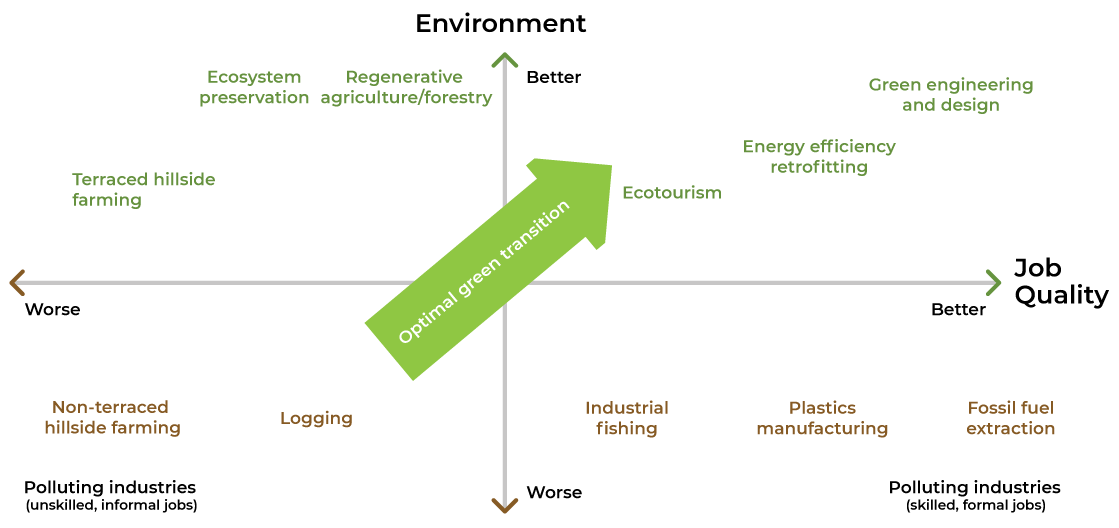The intensifying effects of climate change and ecosystems loss highlight the need for greener economies and greener jobs. Already, workers employed in sectors or locations vulnerable to climate shocks are experiencing productivity and income losses, and in extreme cases, have been displaced from their livelihoods.
To combat the effects of climate change and counter biodiversity loss that threatens ecosystems, it is necessary to adopt more environmentally sustainable patterns of economic production and consumption, requiring greener production technologies, more sustainable inputs to production, and less wasteful consumption patterns. From a sector perspective, it means transitioning to renewable energy, less-emitting transport, climate-adapted agriculture, and more sustainable cities, among others. This shift to sustainable production and consumption embodies the concept of green transition.
Green transition may require new or different labor inputs, and this ultimately results in churning in the labor market as jobs change. Some jobs – such as those in fossil fuel industries like coal mining – will be destroyed, others will evolve and may require new skills, and at the same time new jobs will be created in emerging green sectors. Inclusive transition supports the reallocation of displaced labor to alternative employment and generates improved work opportunities for marginal groups and vulnerable workers.
There are various aspects to green transition, some overlapping, some complementary.
WHAT DOES GREEN TRANSITION MEAN FOR JOBS?
Advanced economies have already begun making the transition to greener, more sustainable production:
- notably through renewable energy and energy efficiency investments and associated environmental services,
- increasingly through electrified transport, and
- incipiently through circular economy innovations and more sustainable agriculture practices.
These greening activities have resulted in some job losses but even more new jobs created. Accurately measuring the number of affected jobs is difficult for many reasons – even in advanced economies with good data quality. Green variables are not well-reflected in most datasets. A job may comprise both green and non-green tasks, so may be only partly green. Jobs can be “green” in terms of carbon emissions but still rely on unsustainable inputs or generate unsustainable byproducts. These examples illustrate the complexity of accurate measurement.
What will green transition look like in developing countries? And what will it mean for job quality?
In the developing country context, job quality varies widely – from subsistence, informal, precarious, low-paid or unpaid work at the low end of the quality spectrum, to stable, formal, high-wage jobs protected by labor regulations at the high end (from left to right along the horizontal “Job Quality” axis below).

Like job quality, green-ness also comes in degrees – that is, some jobs are very good for the environment (e.g., ecosystem preservation) while others are environmentally harmful (fossil fuel extraction). Not all green jobs are good jobs (e.g., terraced hill-side farming, waste pickers); not all brown jobs are bad jobs (highly technical jobs in polluting industries, like coal mining).
This conceptual framing hints at the complexity of defining green jobs and green occupations, and the practicalities of fostering green transition across whole economies, given significant heterogeneity – within and between sectors, and across workers.
Under optimal green transition, countries shift to greener economic activities and workers are able to access jobs of better quality. This type of inclusive green transition could deliver transformative sustainable development in low-income and lower middle-income countries, accelerating their structural transformation.
EVIDENCE OF INCLUSIVE GREEN TRANSITION
There are increasing examples of emerging sectors in this win-win space – that is, better jobs with better environmental outcomes. These include adaptation examples in climate-smart agriculture, nature-based solutions for protecting physical assets and livelihoods (e.g., coastline management, urban storm water management), green public works/payment for environmental services such as forestry conservation, training/policies/incentives for circular economy and local green innovation, and mitigation examples such as renewable energy transition and energy efficiency initiatives for commercial and residential buildings.
The World Bank’s 2021 report on Green, Resilient, and Inclusive Development identifies key sectors that not only drive economic growth but also have significant environmental impacts. The forthcoming Jobs Flagship Report includes deep-dive analysis in some of these key sectors, notably related to energy transition, climate-smart agriculture and food systems, and urban sectors.
